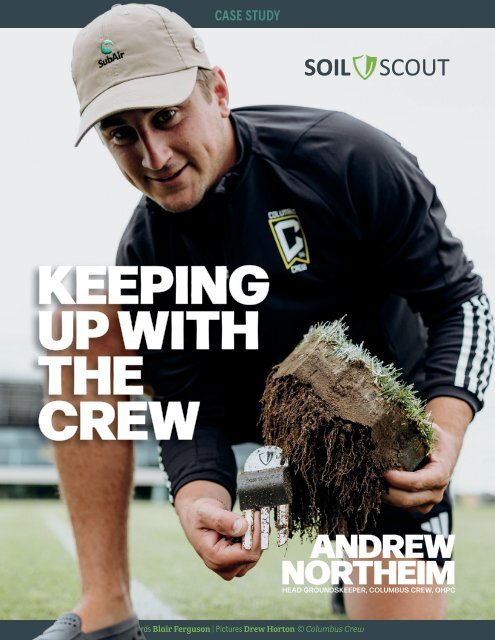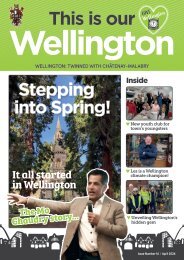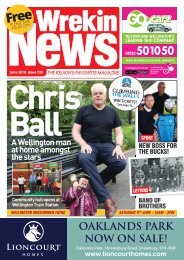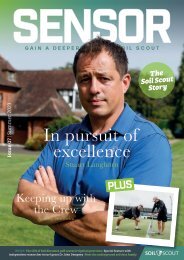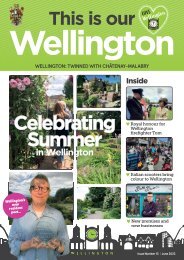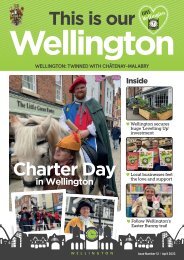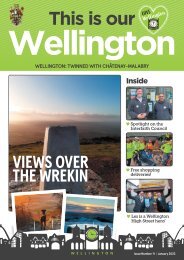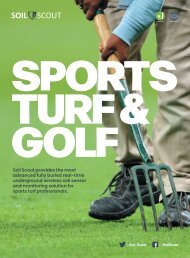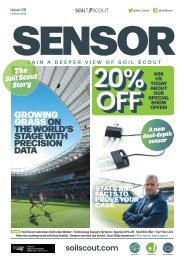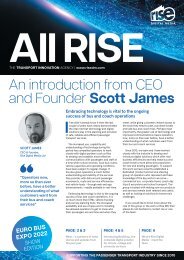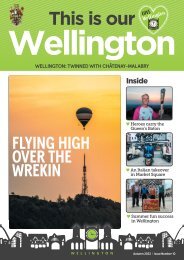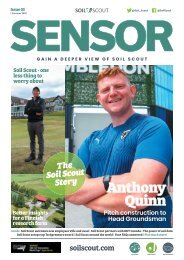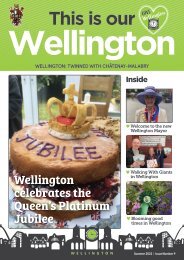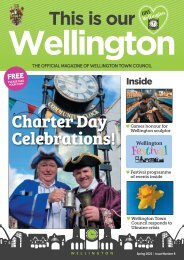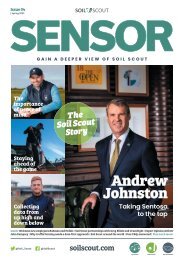Case Study - Columbus Crew
You also want an ePaper? Increase the reach of your titles
YUMPU automatically turns print PDFs into web optimized ePapers that Google loves.
CASE STUDY<br />
KEEPING<br />
UP WITH<br />
THE<br />
CREW<br />
ANDREW<br />
NORTHEIM<br />
HEAD GROUNDSKEEPER, COLUMBUS CREW, OHPC<br />
Words Blair Ferguson | Pictures Drew Horton © <strong>Columbus</strong> <strong>Crew</strong><br />
<strong>Case</strong> <strong>Study</strong> - <strong>Columbus</strong> <strong>Crew</strong>.indd 1 16/01/2024 23:27
CASE STUDY<br />
CASE STUDY<br />
Soil Scout is awesome technology<br />
to have once you have it and<br />
know how reliable it is<br />
The <strong>Columbus</strong> <strong>Crew</strong> hold their own story in the history of<br />
Major League Soccer. As MLS’ first franchise, its evolution<br />
has mirrored the league’s, and on and off the field, it’s<br />
been a case of keeping up with the <strong>Crew</strong>.<br />
Opening in 1999, Historic <strong>Crew</strong> Stadium was the United<br />
States’ first purpose-built professional soccer arena, signalling the<br />
league’s development. Many teams have followed in building their own<br />
soccer-specific stadium, but the <strong>Crew</strong> haven’t stood still.<br />
The possibility of relocation loomed over the franchise, but in 2019,<br />
Dee and Jimmy Haslam, Whitney and JW Johnson and long-time team<br />
physician Dr. Pete Edwards received operating rights of the club and<br />
made their intentions known with investment.<br />
In 2021, the 20,371 capacity Lower.com Field and the renovation of<br />
OhioHealth Performance Center (OHPC), connected to Historic <strong>Crew</strong><br />
Stadium, ushered in a new era for the two-time MLS Cup winners.<br />
For nine years, Head Groundskeeper at OHPC, Andrew Northeim,<br />
has been part of the <strong>Crew</strong>’s journey and seen the transition to best-inclass<br />
facilities. When he joined in 2014 after graduating from The Ohio<br />
State University with a Bachelor’s of Science, Andrew worked at both<br />
facilities and gained valuable knowledge before taking his current role<br />
in 2018.<br />
The development of OHPC was an opportunity to gain field<br />
construction experience and, with the positive backing of the new<br />
owners, embrace the best field technology the industry had to offer.<br />
“When we were initially brought in on the build and heard that SubAir<br />
and hydronic heating was included, it was a pretty big thing,” Andrew<br />
explains. “Knowing that our ownership was willing to invest in the<br />
facilities and fields was a big step.<br />
Andrew Northeim<br />
the latest technology, trying it out, seeing what I like, and seeing if there<br />
is anything bigger and better out there.<br />
“Seeing what Soil Scout could do with SubAir and our hydronic<br />
heating was eye-opening – how they control and automate those<br />
systems together seamlessly, while watching the data, moisture and soil<br />
temperatures from wherever you are is a game changer.<br />
“Once I looked into it, I saw Soil Scout isn’t a new technology, it’s<br />
a technology that keeps improving, and more and more people are<br />
realising it’s a benefit to groundskeepers across the globe like it has been<br />
in agriculture.<br />
“We have SubAir in two of our training fields, but we have three and a<br />
half grass fields. After about six months, I quickly realised that I needed<br />
to get more Soil Scouts in the other fields. We were given 36 sensors from<br />
the original build, and we’re currently on our way to 60+.<br />
“The sensors are just as valuable on the fields without SubAir, because<br />
we can see which fields don’t dry out as quickly. They need their inputs<br />
at different times, and with Soil Scout in them, we can measure that and<br />
prevent waste.”<br />
Subtle differences have become easier to spot for Andrew. Noticing<br />
when pitches are beginning to dry out is one, but watering that area<br />
separately without concern for the rest of the field and saving water is<br />
the real benefit.<br />
By using the Soil Scout cloud, he has streamlined his view of<br />
the pitches. A glance can reveal any variabilities in soil moisture or<br />
temperature, whilst looking a little deeper reveals short and long-term<br />
trends.<br />
The placement of the sensors drives this information. Andrew<br />
is already working at multiple depths of three and six inches, but a<br />
successful trial of the new Soil Scout dual sensor has shown him how<br />
that process will be enhanced further.<br />
“Multiple depths are significant for us because that is what runs the<br />
hydronic heating,” he explains. “It goes off of the three-inch average soil<br />
temperature. If that drops below a half degree, then the heating kicks in.<br />
“You have to rely on those to run the system, and we have no issues<br />
with that. It’s an awesome technology to have once you have it and know<br />
how reliable it is.”<br />
Time doesn’t stand still in MLS for long. Superstars such as David<br />
Beckham come as players and return as club owners, and the league’s<br />
stature grows to attract this generation’s greatest player, Lionel Messi.<br />
Matching the pace of change is imperative so you’re not left behind,<br />
but in the <strong>Crew</strong>, MLS has a team setting the pace from a grounds<br />
perspective, which Andrew thinks benefits the league.<br />
“Being in this league for nine years, it has grown immensely. Just<br />
being on the groundskeeping side, you see all of the new facilities and<br />
teams coming in, building new stadiums and training fields, and putting<br />
in the right technologies for those fields.<br />
“I think that goes a long way from the groundskeeping side in<br />
improving the league for the long term. It’s been crazy from where we’ve<br />
come from at our old training fields and even our old stadium.<br />
“Our old stadium was great, other teams loved coming here, but it<br />
was just a sand-based system that hadn’t been replaced since 2006.<br />
So it was a 14-year-old field we did what we could with, and going from<br />
that to having all this, it shows there’s a lot of new technology in the<br />
groundskeeping world that will help us become even better.<br />
“Ours was the first stadium built, and we were the first team in the<br />
league. Now we have our second stadium and OHPC, so I’d say <strong>Columbus</strong><br />
<strong>Crew</strong> knows you have to keep growing with the league.”<br />
“At our old training facility, we barely had drainage. It was clay soil<br />
with maybe a couple of inches of sand on top, and anytime it rained, we<br />
had puddles across the fields, which we called bird baths.<br />
“So, getting 10 inches of sand for our soil system was great, but having<br />
the SubAir and hydronic heating on top of that was the icing on the<br />
cake.”<br />
Having these technologies in two of the three and a half fields is<br />
one thing, but controlling and monitoring them is another. After being<br />
introduced to Soil Scout and all it would do for the groundskeeping team,<br />
Andrew quickly utilised them across the site.<br />
“Over the years being in groundskeeping, my biggest positive is that<br />
I’m not afraid to try anything new technology or equipment based. I love<br />
<strong>Case</strong> <strong>Study</strong> - <strong>Columbus</strong> <strong>Crew</strong>.indd 2-3 16/01/2024 23:27
CASE STUDY<br />
Watching the data, moisture and<br />
soil temperatures from wherever<br />
you are is a game changer<br />
Andrew Northeim<br />
<strong>Case</strong> <strong>Study</strong> - <strong>Columbus</strong> <strong>Crew</strong>.indd 4 16/01/2024 23:27


